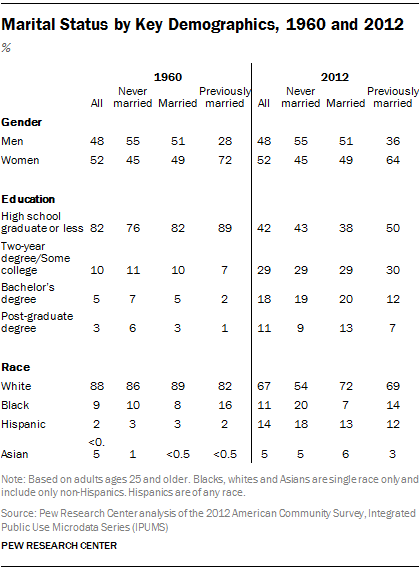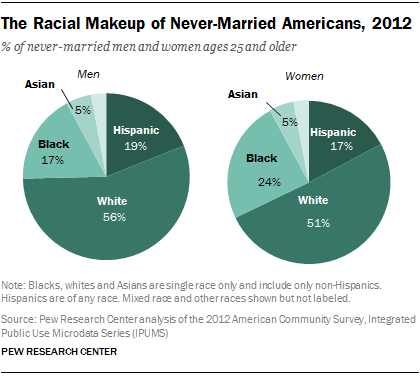 As the share of never-married adults has risen, their characteristics have diverged increasingly from those of married adults.21 Today’s never-married adults are on average younger, less likely to be white and somewhat less educated than married adults.
As the share of never-married adults has risen, their characteristics have diverged increasingly from those of married adults.21 Today’s never-married adults are on average younger, less likely to be white and somewhat less educated than married adults.
Five decades ago, never-married adults were similar to married adults in terms of race, ethnicity and age, and they were somewhat more educated than their married counterparts. Today’s never-married adults are less likely than married adults to be employed (68% vs. 75%); just the opposite was true in 1960.22
In 1960, only about one-in-ten adults ages 25 and older (9%) had never been married. They were somewhat more educated than adults who were married. About 13% of never-married adults had a bachelor’s or graduate degree, compared with 8% of adults who were married. Five decades later, when the share of never-married adults has risen to 20%, married adults are more educated than their never-married counterparts. Some 28% of never-married adults in 2012 were college graduates, compared with 34% of adults who were currently married.
In both years, adults who were divorced, separated or widowed were less educated than never-married and currently married adults.
 The racial and ethnic profile of never-married Americans has changed substantially over the past five decades. Today one-in-five never-married adults ages 25 and older are black, while blacks make up 7% of the married population. The gap was much smaller in 1960, when 10% of never-married and 8% of married adults were black. By contrast, whites are overrepresented among adults who are married. About seven-in-ten married adults (72%) are white, while 54% of never-married adults are white. In addition, about 18% of never-married Americans in 2012 were Hispanic, and 5% were Asian. These shares are close to the ones among married adults (13% Hispanic and 6% Asian).
The racial and ethnic profile of never-married Americans has changed substantially over the past five decades. Today one-in-five never-married adults ages 25 and older are black, while blacks make up 7% of the married population. The gap was much smaller in 1960, when 10% of never-married and 8% of married adults were black. By contrast, whites are overrepresented among adults who are married. About seven-in-ten married adults (72%) are white, while 54% of never-married adults are white. In addition, about 18% of never-married Americans in 2012 were Hispanic, and 5% were Asian. These shares are close to the ones among married adults (13% Hispanic and 6% Asian).
Never-married adults are younger than married adults, and the age disparity has widened over time. Among those ages 25 and older today, the median age for a never-married adult is 35. For a married adult, the median age is 51. Five decades ago, the median age was 43 for never-married adults and 44 for married adults. The median age for divorced, separated or widowed adults was 62 in 1960 and 58 in 2012.23
Never-Married Men vs. Women
 As women have made significant gains in educational attainment and labor force participation, the gap between never-married men and women has widened in a number of ways.
As women have made significant gains in educational attainment and labor force participation, the gap between never-married men and women has widened in a number of ways.
First, never-married women ages 25 and older are more likely than their male counterparts to be college-educated. Some one-third of these women have either a bachelor’s or advanced degree, compared with one-quarter of never-married men. Five decades ago, never-married men and women were much more similar in terms of their education levels.24
Second, among never-married adults ages 25 to 64, women are more likely to be employed than men (70% vs. 67% in 2012). Never-married women first surpassed never-married men in terms of their employment rate in 2008, when 74% of never-married women were employed compared with 72% of never-married men.
Finally, the racial characteristics of never-married men and women are somewhat different now. Today, among never-married women, nearly one-quarter (24%) are black, and about half (51%) are white. By contrast, among never-married men, some 17% are black and 56% are white. The shares of Asian and Hispanics are similar among never-married men and women.
The relative age of never-married men and women has also changed over time. Among adults ages 25 and older, the median age was 47 for never-married women and 39 for men in 1960. In 2012, never-married men and women were roughly the same age, with the median age for men of 34 and for women, 35.25


 Interactive Mapping the Marriage Market for Young Adults
Interactive Mapping the Marriage Market for Young Adults